




13 MARCH 2023 | VOL. 102 | NO. 3 Courage, capability and resilience Planning and tech support ākonga with diabetes Celebrating being Māori at Te Matatini Communities rally on the East Coast

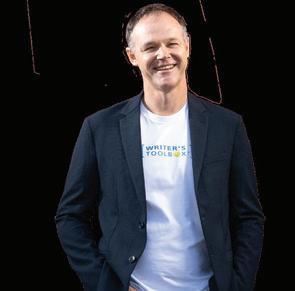


ADVERTORIAL





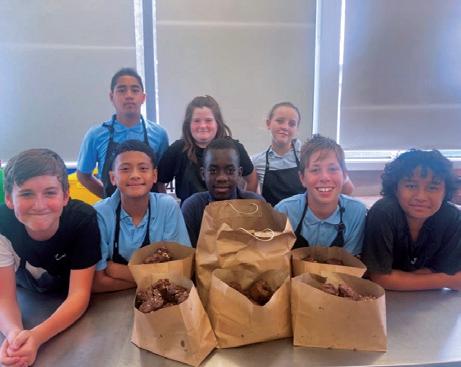

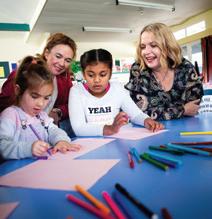



1 Tukutuku Kōrero 4 Communities rally on the East Coast 12 Mental health advice and support after cyclone 16 Tamariki, taiohi and kaiako celebrate being Māori at Te Matatini 22 Māori model of education a pioneer of success 26 Planning and technology support ākonga with diabetes 32 Principles and pedagogy underpin Common Practice Model 36 Sport and culture connects with Kōtuitui 40 Creating change through civics education 44 Day in the life of a school bus controller 48 More support to improve school attendance On the cover Page 4. A small collection of photos from early learning centres, schools and communities in the Hawke’s Bay and Tairāwhiti regions who have come together to support each other through the impacts of Cyclone Gabrielle. MARCH 2023 VOL. 102 NO. Courage, capability and resilience Planning and tech support ākonga with diabetes Celebrating being Māori Communities rally on ISSUE 102.3 Contents Spotlight on wellbeing and community 4 32 26 36 44 48 13 March 2023
EDUCATION GAZETTE ONLINE
Get this in your inbox!
Read each new edition before it’s in print by subscribing to the Tukutuku Kōrero | Education Gazette newsletter. You will get the latest content straight to your inbox, including bonus online articles, videos and podcasts.
Watch: A joined-up approach to learning support
In 2021, we explored how Ōtūmoetai Kāhui Ako uses a coordinated and collaborative approach to learning support, working with agencies and iwi to support the learner and their whānau.
Revisit: Strategies and practical insights to grow resilient schools
Matt Bateman, principal of Burnside Primary School, and Lynda Stuart, principal of May Road School, both understand the importance of building a resilient culture in schools.
To view the PLD, general notice listings and vacancies at gazette.education.govt.nz
Scan the QR codes with the camera on your device.
PUBLISHED BY
Education Gazette is published for the Ministry of Education by NZME. Educational Media Ltd. PO Box 200, Wellington.
ISSN 2815-8415 (Print)
ISSN 2815-8423 (Online)
All advertising is subject to advertisers agreeing to NZME. Advertising terms and conditions www.nzme.co.nz/ media/1522/nzme-advertisingterms-sept-2020.pdf
STORY IDEAS
We welcome your story ideas. Please email a brief (50-100 words) outline to: gazette@education.govt.nz
SUBSCRIPTIONS
eleni.hilder@nzme.co.nz
VIEW US ONLINE Web: gazette.education.govt.nz
Instagram: @edgazettenz Youtube: youtube.com/ edgazettenewzealand
KEY CONTACTS
Reporter gazette@education.govt.nz
Display & paid advertising
Jill Parker 027 212 9277 jill.parker@nzme.co.nz
Vacancies & notices listings
Eleni Hilder 04 915 9796 vacancies@edgazette.govt.nz notices@edgazette.govt.nz
DEADLINES
The deadline for display advertising to be printed in the 4 April 2023 edition of Education Gazette is 4pm on Friday 17 March 2023.
VACANCIES NOTICES PLD
2 Education Gazette gazette.education.govt.nz This publication is produced using FSC® Certified paper from Responsible Sources.
He rau ringa e oti ai
The outpouring of support and aroha for communities affected by Cyclone Gabrielle is deeply moving. As part of my role as editor, I follow many early learning services, schools and kura on their public Facebook pages to keep an eye out for exciting and inspiring mahi – and that is exactly what I found for our lead article in this issue.
I am not exaggerating when I say I was moved to tears – photos of the community coming together to clear up fallen trees and endless mud at education sites, and vice versa, school staff and students out on farms and private homes shovelling mud, baking muffins and treats for volunteers, and offering support at marae and community centres. I’ve seen photos of schools from across the motu hosting fundraisers and donating goods to affected regions, government and local agencies going above and beyond, and in the air, to send out necessary supplies, personnel, and educational materials, and at the end of it all, tamariki laughing and connecting as their centre/ school doors re-open.

I also want to acknowledge the people who are still displaced or just getting by and have not been able to re-join their communities just yet. I have seen such love, patience, and manaakitanga, with the priority firmly focused on wellbeing and healing. I hope the photos offer a small window into the stories from some of those affected regions, with more to come as people find the space to kōrero with us.
Nonetheless, the issue is packed with inspiration for all tūmuaki and kaiako; whether it is helping students through traumatic events, celebrating culture and identity, recognising the value of Māori-medium kaupapa, supporting ākonga with Type 1 diabetes, addressing inequities in education, or broadening your understanding of unique roles like that of a bus controller.

Kia tūpato, ā, me tiaki tētahi i tētahi. Take care and look after each other.
Sarah Wilson, chief editor
Headstrong is a free app, developed by the University of Auckland, dedicated to helping young people in Aotearoa strengthen their mental wellbeing. It’s like a personal trainer for your mind. headstrong.org.nz



NOTE
EDITOR’S
3 Tukutuku Kōrero
13 March 2023
Taiohi (youth) across affected regions are putting in the hard mahi to help their communities recover from Cyclone Gabrielle, like these students from Gisborne Boys’ High School.
GABRIELLE
Communities rally on the East Coast
In mid-February, much of the North Island of Aotearoa New Zealand was dealt a devastating blow at the hands of Cyclone Gabrielle. There have been many stories of devastation and loss, but equally, there are many of bravery, community, Kiwi ingenuity and local heroism. In this series of photos, we explore some of the mahi underway in the hard-hit regions of Te Matau-a-Māui Hawke’s Bay and Tāirāwhiti Gisborne to get early learning services, schools and kura up and running in the aftermath.
 CYCLONE
CYCLONE
Education Gazette would love to publish more stories from our education communities across the North Island and celebrate the incredible actions and resilience of our local people. Please send your photos and ideas to gazette@education.govt.nz.
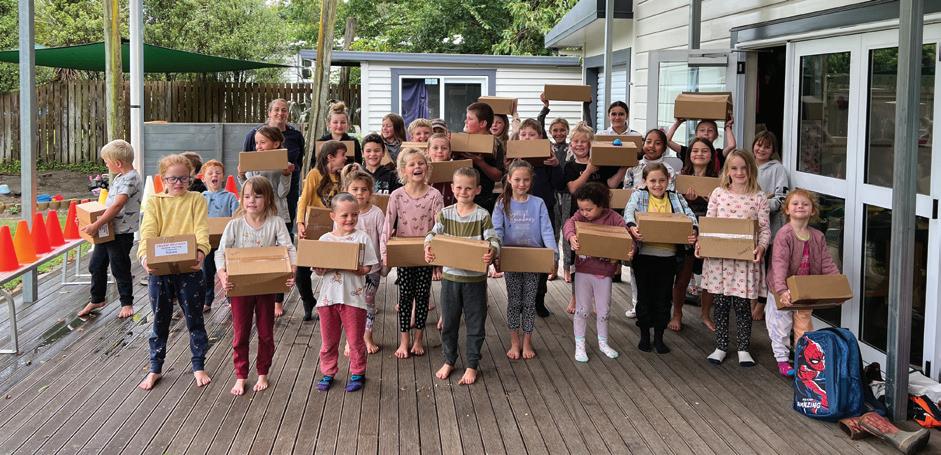
Our thoughts are with those who have been impacted by this severe weather event, and those who have lost loved ones. Kia kaha, kia māia, kia manawanui.
A cross-agency effort saw educational materials and other supplies flown into the rural community of Waihau in the Hastings District.


Left: Local coordinator Sarah Grant collects education packs from the Ministry of Education.
Top: Tamariki at Pātoka School were excited to receive learning packs.
Right: The packs included Anchor UHT Milk, Boring Oat Milk, and The Apple Press juice which was kindly donated by Apollo Foods.
Bottom: MBIE regional advisor Cameron Osmond unloads the supplies from a helicopter that was arranged through the Evergreen Foundation.
5 Tukutuku Kōrero 13 March 2023
the grounds for any other damage, and luckily, there wasn’t. The early learning centre re-opened on 22 February.



 Tamatea Intermediate School had many fallen trees to clean up, including a large 40 year old tree that was likely planted when the school first opened in the 70s.
Tamatea Intermediate School had many fallen trees to clean up, including a large 40 year old tree that was likely planted when the school first opened in the 70s.
6
Tamatea Intermediate School students and their teachers Maia Murray and Sandra Howard baked 200 chocolate muffins as a way to pay it forward to the community who pitched in to help clean up fallen trees at the school.
Above and right: Waiapu Kids Te Hapara Whānau Aroha in Gisborne closed on 13 February in response to Cyclone Gabrielle and National State of Emergency being declared. In the aftermath, the centre had one tree fall and excess water in their outdoor areas. The centre got an arborist in to remove the remainder of the tree that had fallen and assess the rest for risk. Kaiako checked
Pātoka School was one of many in the region left without power, water, sanitation, or road access. On 22 February, acting principal Madelene Field arrived at Patoka School on a boat ride across the river in Rissington to assess the situation. The same day, the Ministry of Education worked with Stead Construction to send two generators and an electrician to Pātoka in a commercially leased helicopter to get the school back up and running.
Top: Stead Construction worked with local contractors to deliver and install a 60kVA Generator at Puketapu School, a semi-rural school six kilometres from Taradale in Napier. They got the school wired up to run the necessities including lights, power, server, sewer and water pumps.
Right: Generators on their way from Palmerston North to Auckland, where they will eventually be delivered to Pākōwhai School, a small, semi-rural school located between Napier and Hastings.

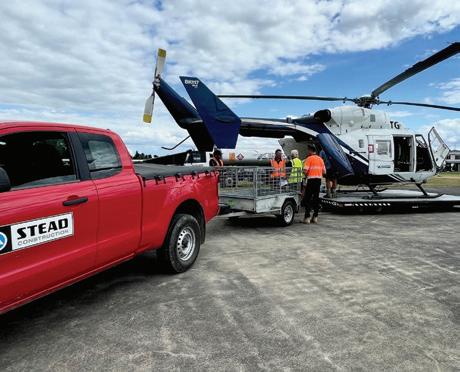

Bottom: Two generators and an electrician on their way to the rural Hastings community of Pātoka.

7 Tukutuku Kōrero 13 March 2023
It was a big clean-up effort at Pākōwhai School – the community rallied together to clean up mud and silt both inside and outside the school. In a Facebook post to the community, principal Tim Race said, “After many hours and buckets of sweat we are able to open for our children. From the food to the brooms we thank you!”


In storm affected areas of Napier, local Ministry of Education property advisor Alan Dibley clocked over 20 kilometres on his road bike to check on affected schools in the hard hit region of Hawke’s Bay.

8 Education Gazette gazette.education.govt.nz
Year 12 and 13 students from Gisborne Boys' High School got stuck into the hard mahi of clearing debris, digging out silt and mud from properties, and helping their wider community recover from damage caused by Cyclone Gabrielle.


9 Tukutuku Kōrero 13 March 2023



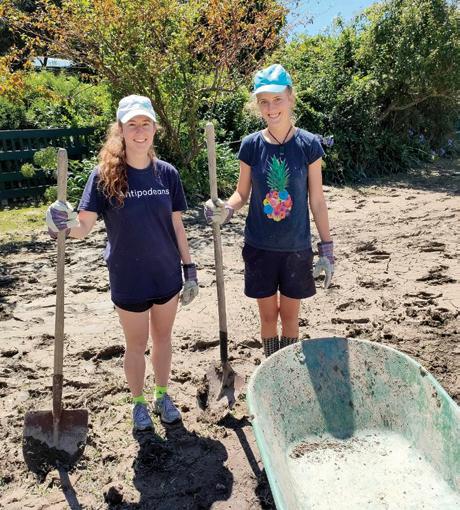
10 Education Gazette gazette.education.govt.nz
Top: Napier Girls’ High School Year 13 students, Maia, Maggie, Helena and Olivia, helping Napier City Council with bags and flyers for food waste.
Left middle: Napier Girls’ Hostel students delivering information updates to communities in Napier with kaiako Mr Otto.
Left bottom: Messages of aroha also came in from Marlborough Girls’ College.
Right: Sisters Samara and Carlee (a Napier Girls’ old girl and a current Year 13 student) getting stuck into the mud and silt at a house in Pakowhai.










Artificial Turf Specialists, servicing New Zealand wide. 0508 836 647 info@teamturf.co.nz www.teamturf.co.nz Multi-use sports courts • Playgrounds • Cricket wickets • Landscaping areas Specialising in: Artificial Turf Specialists
Mental health advice and support after cyclone
Traumatic weather events like Cyclone Gabrielle can have a significant impact on the mental wellbeing of students in affected areas. With parts of Auckland still recovering from flooding and Cyclone Gabrielle destroying homes and livelihoods, as well as taking a tragic human toll, schools are in a unique position to provide support for their students and whānau.

12 Education Gazette gazette.education.govt.nz
HAUORA | WELLBEING
While educators play a key role in supporting communities following traumatic events, principals, teachers and other staff have also been exposed to devastation in Auckland, Hawke’s Bay, Gisborne, Bay of Plenty, Coromandel and Northland and should remember to “put on their own oxygen masks first”, says psychologist, Dr Mary Miller.
In a webinar Navigating the mental wellbeing impacts of flooding: strategies for screening and managing issues, developed after the Auckland floods, Mary explains that everybody has been affected by the disasters and while it may not come naturally, school staff should look after themselves and their families first, as this will resource them to be able to also offer support to students – otherwise, they could risk burnout.
Diverse reactions
The level and duration of flooding impacts levels of distress and existing mental health conditions can be exacerbated. Mary explains that the emotional and social impact of natural disasters such as floods remains long after the water recedes. While it’s normal to have a strong emotional response, some may develop PTSD, anxiety and depression with symptoms continuing for anything from six months to three years. There can be a diverse range of reactions and symptoms; younger children becoming very quiet and ‘good’, or regressing to younger behaviours and angry outbursts. Teenagers can show their anxiety through withdrawal and irritability. They are likely to turn to social media and their peers for support, but they still need adult role models to help them process their experience.
Many tamariki and rangatahi already experience ecoanxiety and are worried about the environment and climate change and climate-related natural disasters are likely to intensify these concerns.

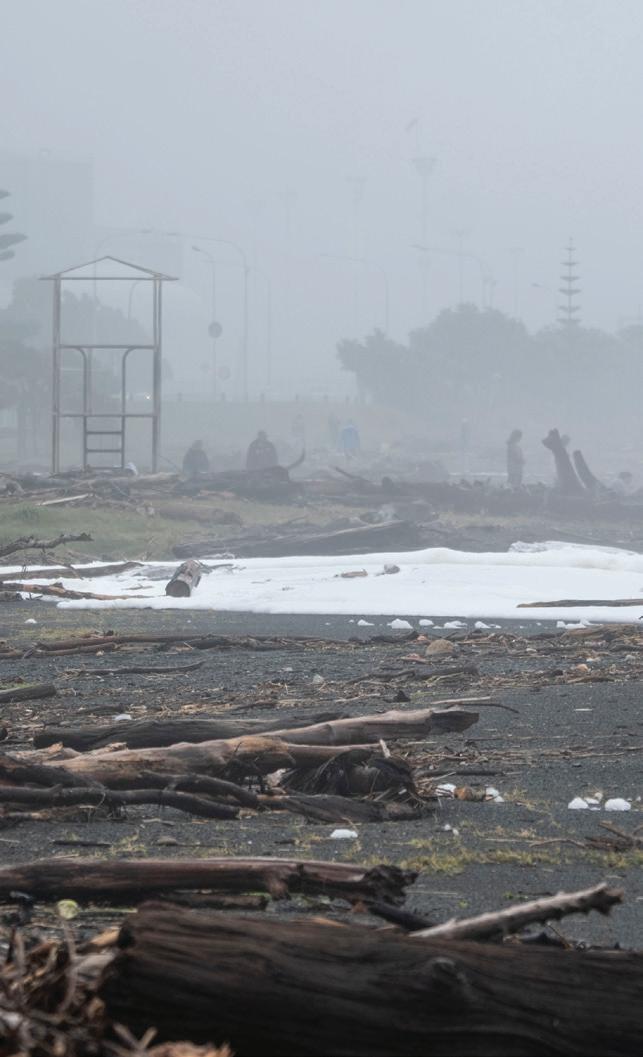
Range of responses
The Kids’ Health website says that when children have faced a traumatic event, they may experience a number of emotional and behavioural responses including:
» engaging in repetitive play that re-enacts the trauma
» having dreams or nightmares about the event, or about themselves or significant others being in danger
» becoming preoccupied with other traumatic events
» becoming very distressed when faced with reminders about the event
» withdrawing from people and wanting to be alone
» losing interest in activities that they usually enjoy
» being alert, tense, and on-edge
» having difficulties sleeping
» experiencing aches and pains – especially stomach aches and headaches
» having difficulty concentrating and paying attention
» being clingy and overly dependent on others
» becoming distressed or fearful if separated from loved ones
» behaving younger, or being generally irritable and acting out
» being angry and verbally or physically aggressive
» having difficulty seeing any future for themselves or loved ones.
13 Tukutuku Kōrero 13 March 2023
“Teachers and school leaders should put on their own oxygen masks first.”
Dr Mary Miller
Screening platform supports mental health
The GoodSpace Schools digital screening platform was developed to enable schools to take a proactive and costefficient approach to student wellbeing. It was piloted in 2021 and in 2022, more than 10,000 students at 89 schools were screened to assess their mental wellbeing.
The initiative was set up by Dr Stuart Jenkins, Dr Subha Rajanaidu, Kate Rhind and Sanjeewa Samaraweera, who all shared a concern about mental health in young people and youth suicide rates. They offer their experience and expertise to the initiative in their own time.
“I’ve come to it because I felt that there could be more effective and equitable ways of coordinating school wellbeing resources,” explains Subha.
“Most schools were set up either reactively, where they need a student to be identified by a staff member or for the student to be confident enough to reach out for help, or they have a main focus on just one year group when the risk was all encompassing across year groups.”
Whole school approach
It’s a tiered whole of school approach. Students complete a survey in real time and any issues of concern are immediately prioritised by school welfare or pastoral teams.
“We ask a range of questions about things that are drivers of poor mental health. It’s all immediately
prioritised so staff can see the students who have answered ‘yes’ to any safeguarding question.”
The students are told what might happen beforehand. A school’s welfare or pastoral team will then reach out to any students with potential safeguarding risks within 48 hours.
“Schools say they found on average 50 percent more students than they were aware of who were carrying potential safeguarding risks; that is anything that needs to be responded to in an immediate fashion from a safety point of view. It could be internal factors such as suicidal ideation or external factors like domestic violence or sexual harm situations,” explains Subha.
Stability and structure important
Subha says that a short-term immediate response to the current post-flood and cyclone disaster to create a sense of stability and structure, with as much parental and community support as possible, will set the stage for the future impacts on mental health.
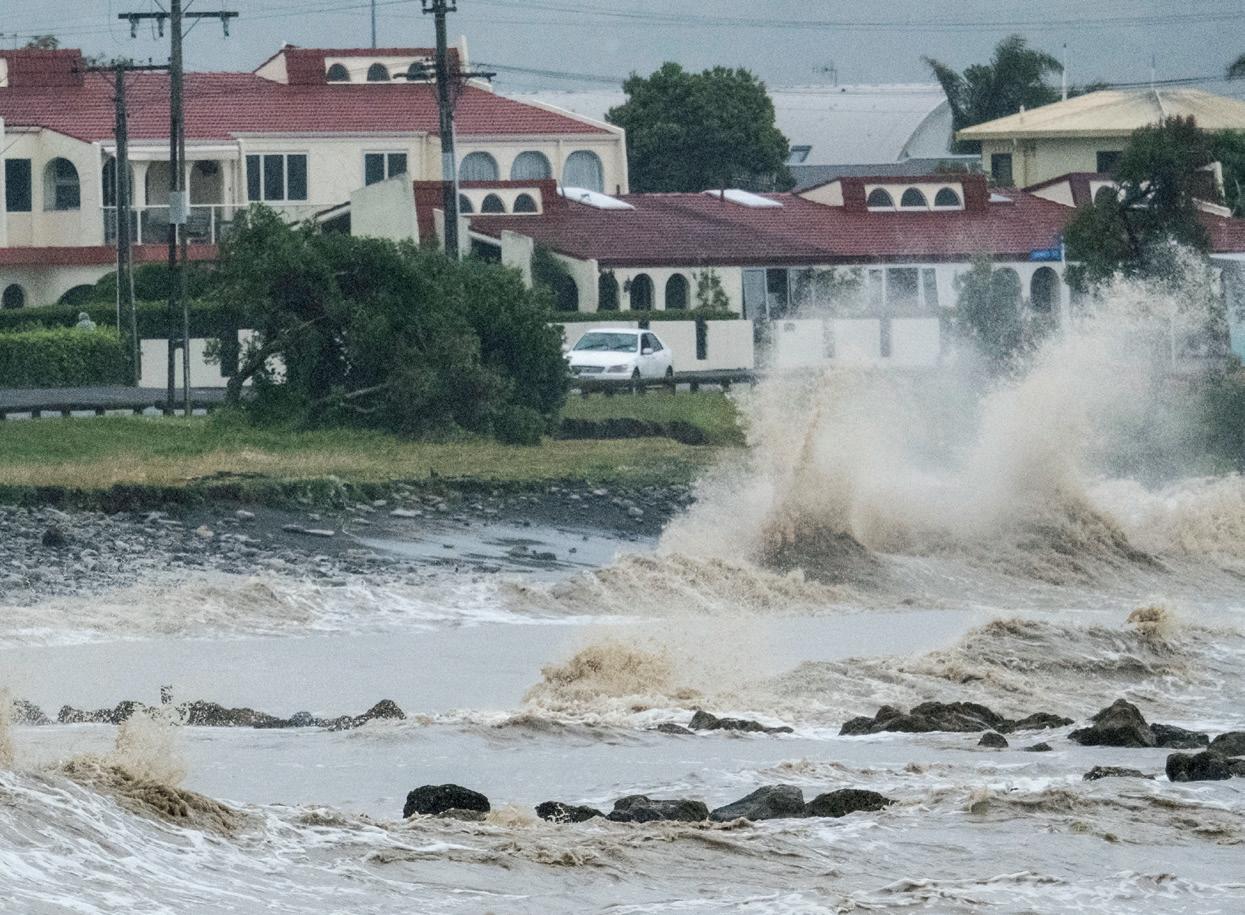
Nevertheless, some students may experience continued distress, with those students with existing mental health concerns having a higher immediate and ongoing risk.
“I think that GoodSpace can help schools identify students who are in need of psychosocial help following a major incident, however I wouldn’t want schools to immediately respond with this tool.
14 Education Gazette gazette.education.govt.nz
“Most students who are in distress currently are experiencing an appropriate response to significant trauma and need to be wrapped with care and support from their whānau and community.”
Dr Subha Rajanaidu
The photographs in this story show the devastation caused by Cyclone Gabrielle / Getty Images
“Most students who are in distress currently are experiencing an appropriate response to significant trauma and need to be wrapped with care and support from their whānau and community. The GoodSpace Schools platform could be part of a toolkit to help schools identify students that may need additional support in the future,” says Subha.

In a blog Supporting student wellbeing after widespread floods, GoodSpace suggests the following key steps schools can take to help support their students:
» Provide a coordinated and comprehensive response in the aftermath of a disaster.
» Provide clear, accurate information about resources and services available to students and families.
» Create a supportive environment where students feel safe and able to express their feelings.

» Provide practical assistance to students and whānau affected by the disaster.
» Promote resilience in the aftermath by teaching students coping skills and providing opportunities for them to become involved in community activities.
» Provide ongoing support for those affected including counselling and mental health services as well as support as students return to their normal routines.
Resources and information

GoodSpace Schools.
Kids Health: Advice for immediate and short term responses; included in this page is guidance on different responses and when to start seeking help.
15 Tukutuku Kōrero 13 March 2023
GoodSpace webinar: Supporting student wellbeing after widespread floods.
Tamariki, taiohi and kaiako celebrate being Māori at Te Matatini
With months of intense training to produce top tier performances – Te Matatini is described by many as the Olympics of kapa haka. Over four days, tens of thousands of fans gathered at Ngā Ana Wai (Eden Park) to soak up everything kapa haka and support their favourite roopū. Among the crowds and kaihaka were students and teachers from around Aotearoa celebrating their identity, culture, and language.

16 Education Gazette gazette.education.govt.nz
TE MATATINI
Some awesome taiohi doing a haka for TikTok.
Te Matatini is the much-anticipated kapa haka festival held every two years, in a different rohe.
This year’s event – Te Matatini 2023 Herenga Waka Herenga Tangata, also celebrated 50 years of Te Matatini. This event was even more anticipated than usual due to the 2021 competition being cancelled because of the Covid-19 pandemic.
This year’s competition, hosted by Ngāti Whātua Ōrakei, saw 45 groups from 13 rohe compete for the top spot. The event – which took place from 22 February to 25 February – brought tens of thousands of people through Eden Park and even more watched from kura, work or home via livestream.
Te Matatini is more than a kapa haka competition: it’s a chance for whakawhanaungatanga me te whakanuia i te Ao Māori (relationships and celebration of Māori).
Celebrating identity, culture, and language
Among the thousands of people attending Te Matatini 2023 are students from around the country – some have come with their kura, schools and others with their whānau.
But the pride these tamariki and taiohi have for their culture and language is evident as soon as you walk through the gates to Te Matatini. Te reo Māori was spoken freely, haka tautoko flowed and Ahurea Māori was proudly on display in all corners.
Te Tāhuhu o te Mātauranga | The Ministry of Education is a proud supporter of kaupapa Māori and this year’s campaign ensured that identity, language, and culture was front and centre. The Ministry tent was one of a record-breaking number of stallholders at Te Matatini 2023. Students gathered with the Ministry’s Te Mahau teams to send a shout out to their favourite kaiako, via te reo Māori, waiata and their favourite haka. These were posted on the Ministry’s TikTok with the hashtag #moeattematatini.
The campaign is focused on ‘Become an influencer, become a kaiako’. The kaiako represented in the campaign were also kai haka who took to the stage over the three days. In addition to the campaign, the kaimahi also focused on gaining an understanding from whānau about their schooling engagement needs.


Students Te Ataakura, Mia and Rereiao from Hoani Waititi, and Erena from Ngā Puna o Waiōrea shared that their favourite teachers are the best because of kapa haka and because they’re really fun.
“To be a good teacher you need to be respectful to your students,” says Erena.
“And you need to learn, but in a fun way,” adds Te Ataakura.
The girls say kapa haka is very important to them and on Friday they were all supporting Te Roopū Manutaki, with Erena also supporting Hātea,
17 Tukutuku Kōrero 13 March 2023
Whangārei teacher Tatyana Te Hira says language, identity and culture is the most important.
The cap sums it up – being Māori was celebrated at Te Matatini.
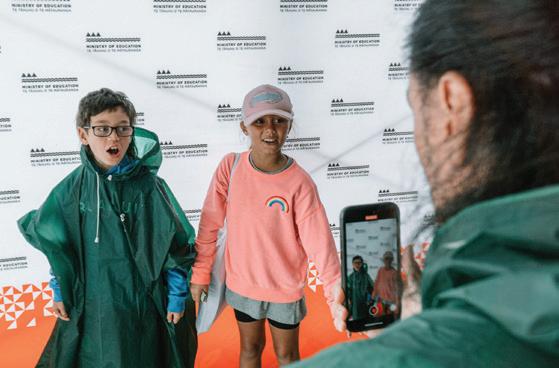


18 Education Gazette gazette.education.govt.nz
“Not many Māori schools get the chance to go to Te Matatini, so this is a really good experience for them, and they get to be part of their culture.”
Waitarehu
Ministry of Education kaimahi with students Erena, Rereiao, Te Ataakura, Mia and Mareikura.
Tamariki were encouraged to perform a waiata and talk about their favourite kaiako at the Ministry of Education’s Te Matatini stall.
Ministry of Education kaimahi with Braydon from Wainui High School.
and Rereiao also supporting Te Pikikōtuku o Ngāti Rongomai.
They say being at Te Matatini allows them to support their whānau, see their cousins and learn how to do kapa haka. The girls say it’s very important to have teachers who respect their language and culture.
“If you don’t, you could make the kids forget where they’re from or forget their language,” they say.
“If you know where you’re from, you know who your whānau is – you know your whakapapa.”
Inspiring kaiako
Waitarehu says her two favourite kaiako are Whaea Lisa, who was her teacher at Finlayson Park School and Kia Aroha College, and Matua Chris, her mau rākau tutor.
“Whaea Lisa helped me improve – te reo Māori is my first language so Whaea Lisa taught me to be out there with te reo Pākeha. Matua Chris, he helped me to be proud, to be confident and to be brave,” she says.
Waitarehu was at the festival with whānau business Kaikihikihi Arts and was also supporting her two sisters – one is a member of Te Waka Huia and the other is a member of Angitu.
She says it is important to have so many kura attending Te Matatini.
“Not many Māori schools get the chance to go to Te Matatini, so this is a really good experience for them, and they get to be part of their culture.”
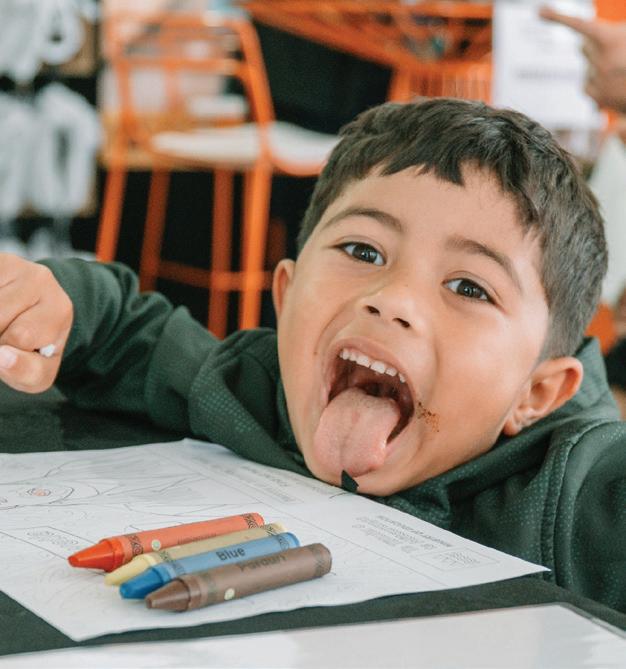
Whangārei teacher Tatyana Te Hira was at Te Matatini supporting the roopū Hātea.
She says one kaiako who inspired her to become a teacher was a kuia named Ngawai Anaru.
“She was a teacher at Tikipunga High School. She was just funny and relatable. She always made jokes which was always fun.”
Passion and dreams
Tatyana has been teaching for five years now and says her favourite thing about teaching is meeting new tamariki and their whānau and engaging with families from the North.
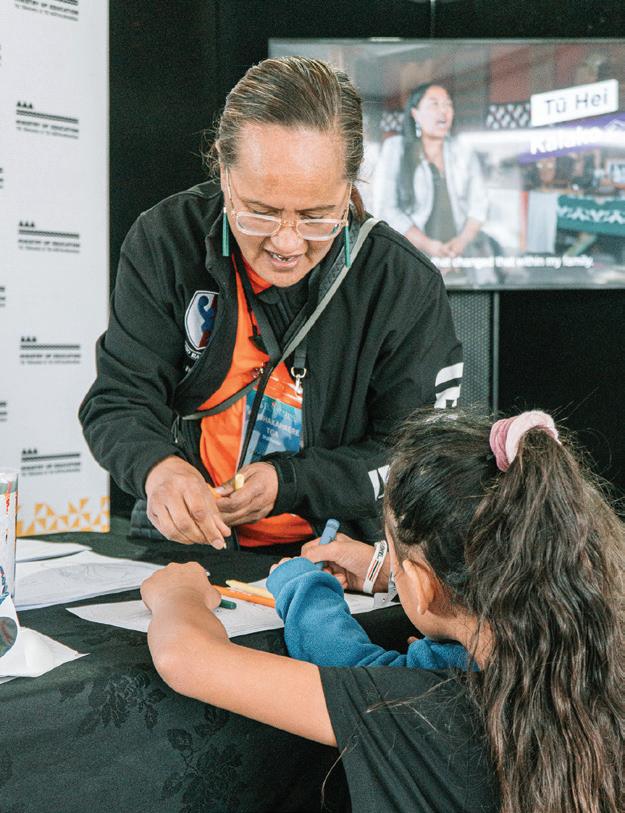
She says language, culture, and identity is the most important.
“That’s sort of the first thing that you use to ground yourself and to make it known about who you are.”
She says she would encourage those wanting to be a teacher to pursue their dreams.
“If you have passion and you love what you do – then it doesn’t really feel like a job.”
The final day of Te Matatini drew many people from all walks of life to Ngā Ana Wai. After rain poured on Friday afternoon, the sun came out on Saturday for supporters – young and old – who gathered to tautoko the finalists and await the overall results.
After four days of kapa haka, whanaungatanga and celebrating Māori language and culture, Te Kapa Haka o Te Whānau-ā-Apanui from the Mātaatua rohe, were named the supreme winners for the third time.
The Aotea rohe which embraces the Taranaki/ Whanganui district will host Te Matatini National Kapa Haka Festival in 2025.
19 Tukutuku Kōrero 13 March 2023
Tahi, rua, toru, whā – pukana!
Parehuia Nepe, lead Māori education advisor, helping tamariki colour in at Te Matatini.


20 Education Gazette gazette.education.govt.nz
Students gathered at the Ministry of Education tent and performed waiata and haka.
Waitarehu (right) singing a beautiful waiata at the Ministry of Education stall.
Whakaaweawetia te āpōpō hei Kaiako


“My dad knew the families quite well. So, he used to go to their homes and tell the kids to get out of bed and go get in the van and go to school.”
Arihia Stirling
Arihia is proud of the achievements of Te Kura Māori o Ngā Tapuwae.
Māori model of education a pioneer of success
Māori-medium education is successful in achieving exceptional outcomes for ākonga Māori, and much of this is down to the mahi of educators who have fought to achieve recognition for the value of Māori-medium kaupapa.
Last year marked 40 years of success in Māori-medium education, and for the many Māori educationalists who have had, and still have, a vision of how education can deliver exceptional outcomes for ākonga Māori.
One of these early educators is Te Kepa Stirling, who established Te Kura Māori o Ngā Tapuwae with his wife, Pani Takawhenua Waipapa Stirling. The Māori unit was fully operational when the school changed names from Ngā Tapuwae College to Southern Cross Campus. The Māori unit continued under the name of Te Reo Rua o Ngā Tapuwae and grew into a successful standalone Kura Māori.
In 1975 Pani was given the choice of being head of the Māori department at either Ōtāhuhu College or Ngā Tapuwae: she chose the latter as it was a new college.
Ngā Tapuwae was intended to be a ‘community college’, and extensive community facilities were developed over the years. This included the first crèche on a school campus. In 1976 Te Kepa, who had been a carpenter, retrained as a kaiako Māori and became the physical education and Māori teacher at the college.
His daughter Arihia Stirling, QSM, who is the current principal of Te Kura Māori o Ngā Tapuwae, explains that at that time the area was growing thanks to a migration from the inner city into the suburbs.

“It was at that particular time, like returning to the land of milk and honey. There was lots of work all around. Our people at that time had moved to the cities and never knew anything but work. So work was plentiful.”
Unfortunately, in the mid 1980s, work ran out with the closure of meat works and other industries that had been a mainstay of employment. This led to depression amongst families, and ākonga started to stay away from school.
23 Tukutuku Kōrero
MĀORI EDUCATION
The Stirlings set up a pastoral care system with a focus on getting the Māori students back into school.
“My dad knew the families quite well. So, he used to go to their homes and tell the kids to get out of bed and get in the school van,” says Arihia.
The pastoral care system called Te Whare Awhina was the first of its kind and allowed the parents to deal with the grief of being out of work whilst creating a reprieve for the children to be out of the house. The system started with just two form classes and then grew to being a full bilingual unit called Te Reo Rua o Ngā Tapuwae.
“By the late 80s, the place was humming because of what Mum and Dad had done, which was build a whānau system where families could come to be a part of our school whānau. Dad built a marae – Te Whare Wananga Pupuri Korero o Ngā Tapuwae at the same time, which got people in and helped a lot of displaced people,” says Arihia.
The Whare Wananga became a place where people from different rohe could come together and celebrate being Māori. This became the hub for the Ngā Tapuwae experience, and they built strong social support for ākonga and whānau to achieve success.
Conflicts and triumph
The unit grew in strength which created tensions with the remainder of the college, where numbers had dropped. There were conflicts over the composition of the board; whilst Kepa had managed to have supporters of the unit voted in, this did not resolve the conflicts and in 1994, Minister of Education Lockwood Smith sacked the Board of Trustees.
Although an Education Review Office (ERO) review said that the unit was excelling and had academic levels higher than the rest of the school, there were moves to try and close the unit. The board was replaced by a commissioner whose role was to ‘sort out’ the unit.
“In February when we went back to school as teachers, we were all told that the principal was gone, that [Sir] John Graham is now the commissioner, and this is how it’s going to be.”
John was reluctant to keep the pastoral care system that had been created, but Kepa was adamant to fight for what they had created.
Arihia says her father told him, “I’ll shed blood for what I believe in. So obviously, we’re going to have to have some conversations.”
Arihia took over as the leader of Te Reo Rua o Ngā Tapuwae and continued these conversations. Her initial feelings were to take an activist approach, but she adhered to her mother’s teachings.

“My mother said be assertive. At this moment we need to be smart and strategic. We need to prove that we actually know what we’re doing.”
They were able to prove this, to the extent that John told them that they needed to start their own school which would provide the same opportunities for younger ākonga.
From there, in 1996, Te Kura Māori o Ngā Tapuwae was founded as a school within a school, which shared a site with Southern Cross Campus.
24 Education Gazette gazette.education.govt.nz
“The desire of the people was so strong, they did not wait for funding. We were united in our belief to save the reo and pass the reo on to our children as part of our future wellbeing.”
Hilda Halkyard-Harawirae
Te reo Māori provides support for tamariki Māori.
The status of Te Kura Māori o Ngā Tapuwae as a school began in 1997 with the appointment of its own director. Te Kura Māori o Ngā Tapuwae officially opened as a Kura-ā-Iwi in January 2011 and has continued to deliver exceptional outcomes for Māori learners ever since.
Arihia credits this achievement to the determination of her parents, as well as the guidance and support of the late Sir John Graham
“It was very lonely being a young, Māori principal, but under the leadership and guidance of Sir John Graham I was able to navigate the institutional spaces, and with that support and that constant guidance from 1997, we finally got our own school in 2011.”
Activism and education
Hilda Halkyard-Harawira, former principal of Te Rangi Āniwaniwa, a kura kaupapa in Kaitaia, is also heavily involved in fighting for kaupapa Māori and Māori education.

Hilda was born at Mangonui and educated at Hillary College. In her early years at university, she became involved in activism, which carried through to her role as an advocate for reo Māori education.
“Education is a powerful tool of liberation, and I was lucky enough to have had good teachers at Hillary College, and I vowed to become a good teacher for our youth in the reo Māori space.”
She is proud of being a founder of Āniwaniwa Kōhanga Reo, Te Rangi Āniwaniwa and Te Wānanga o Te Rangi Āniwaniwa.
In February, Te Rangi Āniwaniwa celebrated its 30th anniversary. Twice in its history it has capped its roll, the first time at 100 students, which prompted another kura kaupapa Māori to start – Pukemiro.
Last year, a third kura kaupapa, Tūtūtarakihi was officially recognised by the Ministry of Education. A fourth kura is due to open in Ngāti Kahu in the near future.
The local kohanga reo teach their mokopuna the foundations of te reo basics ie karakia, waiata and pepeha. They feed into Te Rangi Āniwaniwa, which is situated next to Kaitaia Airport.
Te Rangi Āniwaniwa grew out of the Ngāti Kahu, Te Aupōuri and Te Rarawa Trust. The trust established Āniwaniwa Kōkiri Centre, and the mothers of those involved in the Kōkiri helped establish Āniwaniwa Kōhanga Reo. They still wanted more opportunities for their children to continue learning in te reo Māori, hence the development of Te Rangi Āniwaniwa.
While it took time for Te Rangi Āniwaniwa to gain Kura Kaupapa Māori status, this did not prevent the school from starting.
“The desire of the people was so strong, they did not wait for funding. We were united in our belief to save the reo and pass the reo on to our children as part of our future wellbeing.”
Since 2013, Hilda has been the voluntary advocate for Te Kōtiu, Te Kāhui Tumuaki o Ngā Kura Kaupapa o Tai Tokerau. Her role is to advocate for anything to support whānau and learning in the kura kaupapa space in Tai Tokerau.
“I call myself the Mini-star of Mātauranga Māori in
Te Tai Tokerau – Minister Kelvin Davis’ counterpart in the northern kura kaupapa Māori sphere of influence.”
Pioneers of successful education
Hilda sees Kura Kaupapa Māori as having the highest success rate in education attainment. As part of her current activities, she is part of a group awaiting the opportunity to present an urgent claim to the Waitangi Tribunal on behalf of Kōhanga Reo, Kura Kaupapa, Kura a Iwi and Wānanga Māori. The group want to establish a separate parallel Māori education pathway that caters for their highly successful model of education.
“The new initiative of Kelvin Davis, Te Hurihanganui, is outstanding for mainstream schools. But we have pioneered that track 30 to 40 years ago and we have different goals, needs and we are over the one-size-fitsall, mark time for another 30 years, model,” says Hilda.
In terms of future progress, some achievements
Hilda would like to see is funding being invested early to support tamariki Māori in their learning and te reo Māori continuing to be a main support for the wellbeing of Māori.
Both Hilda and Arihia want to see a continued support for whānau, as this is an important aspect for ākonga achievement.
“Children are the most valued, but without families, we don’t have good children,” says Arihia.
“Our success is about nurturing the social issues of our family and busting all the barriers that cause stress for family members that make them not able to feel the joy of their children. Schools like us do that. Māori schools do that.”
25 Tukutuku Kōrero 13 March 2023
Te Kepa Stirling and his wife the late Pani Takawhenua Waipapa Stirling have been a strength in Māori education.
Planning and technology support ākonga with diabetes
For Sandringham parent Juliet Short, the start of the 2023 school year for daughter Grace, who has Type 1 diabetes, involves extensive daily planning beyond the need for uniforms, books and lunches. But a strong support network at school goes a long way to ease the challenges.
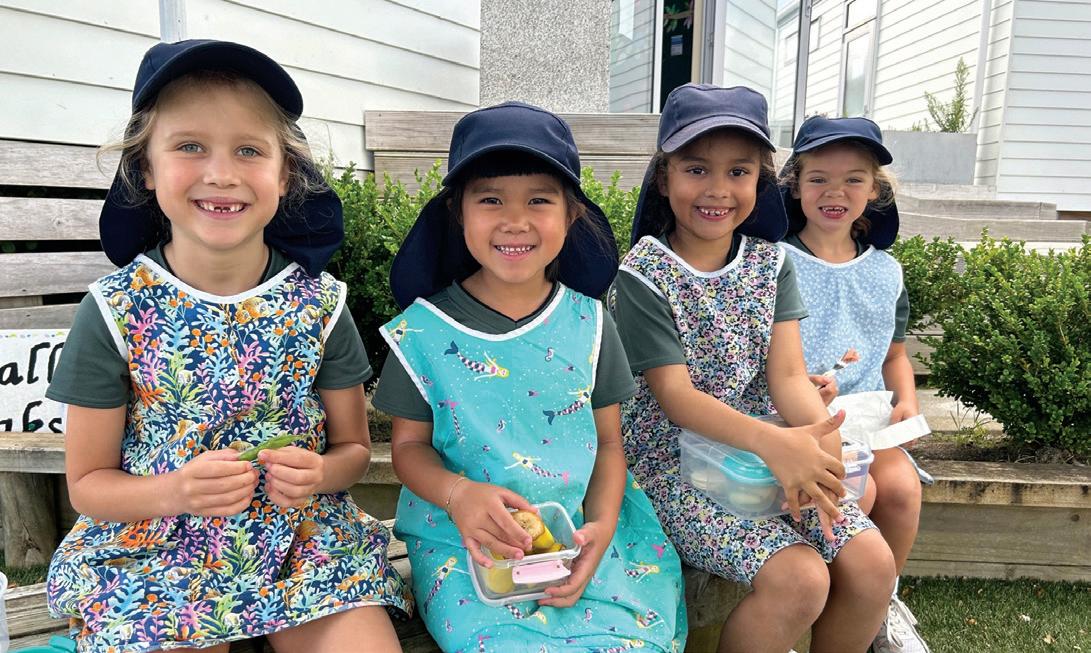
Six-year-old Grace was diagnosed with Type 1 diabetes when she was three. It’s a life-changing condition where the body’s immune system attacks the pancreas and destroys the body’s own insulin-producing cells. Technology and a strong support network at home and school are helping Grace to have as close to a normal childhood as possible.
“Our family’s preparations for the 2023 school year include arranging any training that my
daughter’s school support team needs to feel confident caring for her; arranging for medical supplies and extra snacks to be kept at school, and planning for sports, field trips and other school events that may cause high or low blood glucose levels,” explains Juliet.
Grace is lively and independent, but when she was diagnosed with Type 1 diabetes, her parents Juliet and Nick set out to do all they could to help navigate the challenges of the life-long condition so Grace can concentrate on her learning, friendships, and sports.
26 Education Gazette gazette.education.govt.nz
WELLBEING/HAUORA
Grace (left) enjoys spending lunch time with friends at St Cuthbert’s Junior School.
Constant management
Living with Type 1 diabetes requires constant management of food and activity, along with frequent finger-prick blood tests and insulin injections several times a day. Technology in the form of insulin pumps and continuous glucose monitors can also be used.
From the beginning, Grace’s parents purchased a continuous glucose monitor (CGM) which is attached to Grace’s arm and takes blood sugar readings every five minutes. As well as removing the need for frequent fingerprick tests, the CGM sends a live-stream of information to a cellphone and can provide early warning of high or low blood sugar levels.
“We are extremely privileged to have been able to afford a CGM from the very early days – but I’m very conscious that not every Type 1 diabetic child has that privilege. There’s nothing I would like more than to see CGMs funded for all children living with Type 1 diabetes,” says Juliet.
Learning curve
There are around 28,000 people living with Type 1 diabetes in Aotearoa – around one out of 500 secondary school students and one out of 1,200 primary school students will have the condition.

Supporting a child with Type 1 diabetes can feel overwhelming for teachers, but schools are experienced in supporting students with additional needs, including making use of a wide range of resources and information.
“It’s quite a learning curve because I guess when you take on a Type 1 child, you’re told if their blood sugar goes too low and you don’t act immediately, they could end up unconscious, and if they spend too much time high they are at risk of long-term complications, which is nerveracking,” says Juliet.
“The biggest thing for schools is educating themselves around what Type 1 diabetes is: the physical and psychological management. It’s OK to acknowledge that having a Type 1 diabetic student in your class is a huge learning curve, but at the same time when you know a bit about it, it gets a lot easier. There are a lot of great resources you can use to self-educate.”
Grace was diagnosed when she was at kindergarten, and Juliet says they tended to monitor her blood sugar remotely and would be constantly texting instructions.
“Grace’s ECE teachers were an amazing, caring bunch of people, and they made it work but it was very hard when she was first diagnosed. Her blood sugar levels were very volatile and there was no teacher aide support available.”
Juggling act
Grace’s new entrant teacher at St Cuthbert’s Junior School had no experience of Type 1 and Juliet spent time with the teacher and teacher aide getting them comfortable with what was required.
“When she first started school, I made myself available to be on site as much as they wanted – it was probably only two days when I was fully on site and then they got into the swing of things, and we just texted when they wanted a bit of back up.”
27 Tukutuku Kōrero 13 March 2023
“It’s OK to acknowledge that having a Type 1 diabetic student in your class is a huge learning curve, but at the same time when you know a bit about it, it gets a lot easier. There are a lot of great resources you can use to self-educate.”
Juliet Short
Teacher aide Renee Sharp supports Grace during school hours.
When she started school, Grace had a Dexcom G6 CGM which takes a blood sugar reading every five minutes and sends the data to a cellphone as well as to anyone who is following her Dexcom App on their cellphone, such as parents, a teacher, or teacher aide.
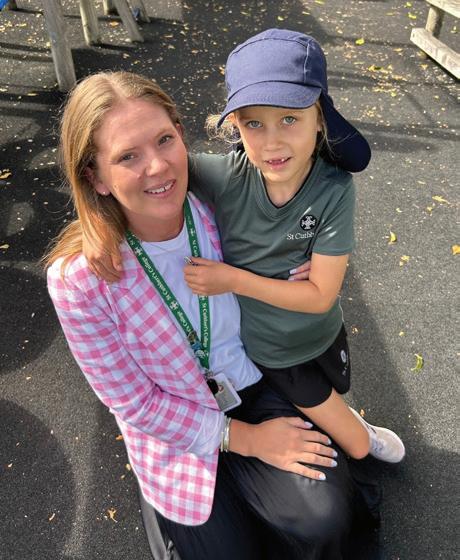
Grace has been using an insulin pump, rather than insulin injections, for the past year.
“The pump does the calculations so when she takes her lunchbox to school, we put a note on the top of it saying this is how much carbohydrate is in each item in the lunchbox and then they enter that in the pump and the pump calculates how much insulin she needs. The pump also talks to her CGM – if she’s running a bit low, the pump will automatically reduce her insulin; if she’s a bit high, it will give her extra insulin.
“That’s made a huge difference in the number of decisions and interventions we have to make. The number of times we touch the pump every day has dropped a lot, which is wonderful for her.
“It’s a constant juggling act, but we are very grateful that she has a funded teacher aide to support her until she gets to the stage where she is self-managing,” says Juliet.
Classroom challenges
While people with Type 1 diabetes are on a blood sugar rollercoaster 24/7, Grace has the support of a teacher aide, Renee Sharp, who accompanies her through the day and helps her manage her blood sugar and the technology.
Grace is the fourth Type 1 diabetic student classroom teacher Liz Stevens has taught.
“I started 11 years ago with a little boy in my class; I didn’t know anything about Type 1 before then. He went home unwell from school, and I got a phone call that night to say he was in Starship with Type 1 diabetes.
“He was in Year 1 when he was diagnosed. I went straight into getting as educated as I could, but it was a big learning curve. I was working in a junior classroom and we managed doing finger pricks every hour. The responsibility to be always worried about his blood sugar
levels and managing a whole other class as well was a big shift,” she says.
Having a student with Type 1 diabetes can be overwhelming to begin with.
“My advice if you are told you will have a Type 1 student in your class is to learn as much as you can. The more you know, the more prepared you feel,” she says.
Dreams and goals
Grace is now in Year 2 at St Cuthbert’s Junior School in Auckland. She loves writing, swimming and sport.
“When I go swimming, I can take the pump off and put it back on. I disconnect and reconnect it – it’s easy,” says Grace.
“There’s the odd time when her blood sugars go low and she has to sit out PE, which she gets a bit dark about because she loves her sports,” says Juliet.
A special kitbag containing juice, glucose tablets and back-up medical supplies goes everywhere with Grace. With the aid of the insulin pump and CMG, Grace can now play with friends at lunch time without Renee.
“We always have an adult watching when she boluses [administers a dose of insulin] but having the technology has allowed her to take so much more ownership at a young age. From a teacher’s point of view, that is so cool to see,” says Liz.
During play and lunch times, Grace carries her phone in a pouch and Renee monitors her remotely.
“It’s amazing because we found having a teacher aide beside her all the time meant she just didn’t have the normal playground interactions with her friends. Renee has picked up both the physical and psychological sides of diabetes management so quickly and is doing an amazing job of supporting Grace in her goal to eventually manage her blood sugar levels independently,” says Juliet.
“Grace knows how to unlock the pump and deliver an insulin bolus and she is starting to recognise when she is high or low and decide what to do.”
One of Grace’s dreams is to catch the school bus. “When she can reliably manage a low [blood sugar], she’ll be able to go on the school bus,” says Juliet.
Supportive classmates
Reflecting on why things have been manageable so far, Juliet acknowledges Grace’s independent attitude along with the technology and support from kindergarten and school. Classmates have also been a big help.
“One thing we have done from the start, with Grace’s permission, is we have always been very open about things and made sure that classmates feel they can ask questions. Children are mostly just curious. The ones who have been in her class from New Entrants are used to it.
“One day the teacher called out to the teacher aide ‘how’s our girl doing?’ On the cellphone which can be seen in the classroom, there’s a Dexcom line. If she’s too low, it will be red and if too high it will show yellow. If she’s in the right range, it’s grey. One of the girls in Grace’s class called back ‘she’s fine, she’s in the grey’,” concludes Juliet.
28 Education Gazette gazette.education.govt.nz
Liz Stevens has had a lot of experience with tamariki with Type 1 diabetes.
Grace is lively and social and enjoys playing with friends at school.
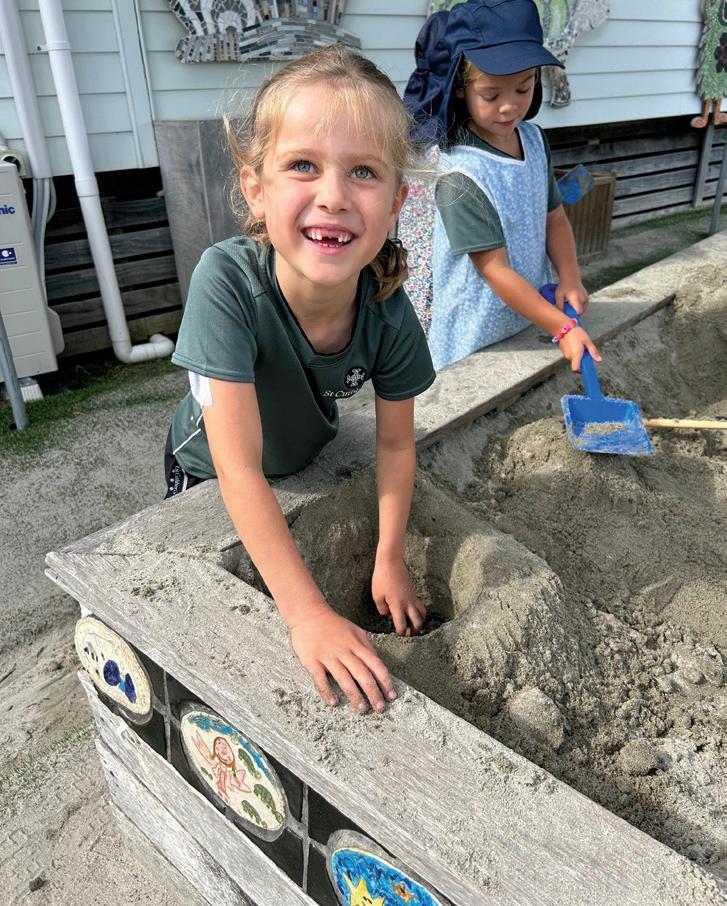
Resources for teachers
Starship resources for schools
Bullying-Free New Zealand needs you.
Diabetes NZ resources for schools/ ECE centres
Beyond Type 1 – a US-based website School resources
Beyond Type 1 – a US-based website A Teacher’s Guide to Kids with Type 1 Diabetes
Dexcom guide to support students who use CGMs
School leaders, teachers, Board of Trustees – help improve bullyingfree.nz by completing this 7-minute survey.

To access the survey, use the QR code below or https://www.surveymonkey.com/r/Bullying-freeNZ
The survey closes on Friday 24 March 2023.
29 Tukutuku Kōrero 13 March 2023
 The CGM on Grace’s arm, along with an insulin pump, gives her greater freedom to be active and independent.
The CGM on Grace’s arm, along with an insulin pump, gives her greater freedom to be active and independent.
An amazing new STEM resource
from Genesis School-gen & Nanogirl Labs
• STEMSTARS brings STEM to life through the power of storytelling and fun activities.
• Eight exciting ‘STEM Labs’ with activities suited up to Year 6.


• Everything teachers need to deliver STEM lessons with confidence.
Find out more at schoolgen.co.nz/stemstars

32 Education Gazette gazette.education.govt.nz
Minister of Education, Jan Tinneti during a visit to Konini Primary School in Wainuiomata along with colleague, MP Ginny Anderson.
Principles and pedagogy underpin Common Practice Model
As a former teacher and principal, Minister of Education Jan Tinetti says she’s passionate about the potential of the Common Practice Model (CPM) to support teachers and kaiako to achieve the best outcomes for ākonga.
The Common Practice Model (CPM) incorporates evidence-informed pedagogical approaches and practices that will better support all educators and address inequities in education. It’s being developed collaboratively and reflects sector experiences, evaluation and research findings. The CPM is part of the larger body of work to support literacy, communication and maths through Te Whāriki and the refresh of The New Zealand Curriculum
Education Gazette asked Education Minister Hon Jan Tinetti why the model could be a real game changer.
Q. Why do you think the CPM, the Literacy & Communication and Maths Strategy and the Curriculum Refresh are important at this time?
A: Literacy, communication, and maths are foundational areas that young people need to succeed in life. For many years teachers have told us that they don’t have enough clarity or direction in achieving what we want them to achieve. I can attest to this having come out of the sector – the number of approaches I adopted over the years! We
just haven’t had consistency across the sector of the principles that underpin really good practice and the pedagogies that will get us there.
The Common Practice Model to me is the essential part of the Literacy & Communication and Maths Strategy because it’s going to guide teachers in delivering the best possible teaching, learning and assessment. In all of that we have to make sure that the Curriculum Refresh is part of this and that our teachers have a totally integrated approach to everything they’re doing.
The principles that underpin good practice are really important and we want to ensure that our teachers are feeling confident and capable – not grasping at straws. Every teacher wants to do a great job for their kids but sometimes they lack confidence because we haven’t been consistent in the messaging and support that we’re giving to our workforce to be able to achieve those goals.
For me, the CPM is the cornerstone of the Strategy and the Refresh. If we get this right, it’s going to support our workforce to be the best that they can be.
33 Tukutuku Kōrero 13 March 2023
CURRICULUM
“We’re trying to create an even playing field, and I think we’re right on the cusp of achieving that.”
Jan Tinetti
Q: You’ve told me what your vision is – do you think it’s achievable?
A: I 100 percent think that it’s achievable and the reason I say that is because we’ve got a workforce that’s crying out for it. We just have not addressed this until now. That’s why so many schools have adopted practices that might look different to what we were doing 20 years ago, they’ve done their own research. Let’s get that consistent across the system that we have.
Teachers are wanting to be engaged in this. I acknowledge the fact that there’s been a lot of pressure on teachers in the last few years, but what teachers tell me is that they know if they put the time in now, it’s going to give more clarity and make things a lot easier for them to understand down the track.
Having said that, I also am aware of the pressures that we put on teachers and those are things that I am constantly weighing up all the time. I just hope that this is key to making changes in our system.
Q: One of the aims of the Common Practice Model is to address inequities, particularly for Māori and Pacific children. How do you think a Common Practice Model will achieve this?

A: It’s considering all of the settings that we have and the different young people that we have in the country. We have to make certain that we don’t just have a generic take that doesn’t consider different aspects that young people bring to the education process. That’s what the experts have been working through.
What the model will do is consider the teaching and learning pedagogies and practices that we know work for all of our learners. But it will have a particular focus on the needs of those who are not having their needs met within the current system. The CPM will give direction and flexibility for educators to be able to target those learners as well.
Q. This is a very large piece of work – what kind of timeframe is achievable and what is required to move it forward?
A: It is a large piece of work, so we have to be realistic about that. It will take time and that’s why we’re getting this first part out into the sector now. It focuses on pedagogical approaches, then we will look at pedagogical practices: we know that teachers are raring to go and are wanting to be engaged in this. I really believe that we can achieve this very quickly. But to get it embedded, we have to be realistic that it will take time, resources, and professional learning supports.
This is the first tranche, but as it develops there will be discussions, for example, about what might work for different learners. We’ve seen a lot of schools that have started their own research in these areas and they’re already down the track in many instances. This is just bringing the research together. I was in the sector for 27 years and this is the first time I feel that has been taken into account. And I feel that this is going to serve those young people so much better than we have done before.
34 Education Gazette gazette.education.govt.nz
The CPM could be a real game changer, says the Minister of Education.
Q: What would you like teachers, kaiako, leaders, experts to do to engage with the CPM?


A: Our teachers are the experts here, they work with our young people day in, day out, so we want to get this right. We need them to read the Common Practice Model and think about how it relates to them in their setting. We need teachers who work with all demographics of young people to engage in this.
Having been a teacher, I so value that voice. I value what we can get right here, but also what we could potentially get wrong because we aren’t listening to the sector. The Ministry will be organising webinars to talk about what’s been developed and why, and I really encourage you to attend those, and then they’ll be looking to test the Common Practice Model with kaiako and leaders later in the year.
We’re trying to create an even playing field, and I think we’re right on the cusp of achieving that.
Education Gazette profiled the Common Practice Model including kōrero with five members of the contributors’ groups in Issue 2, 2023
Literacy & Communication and Maths Strategy – Education in New Zealand
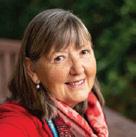
Common Practice Model – Education in New Zealand
PPTA Education Conference
17– 18 April 2023
PPTA Te Wehengarua Education Conference 2023
Registration is open for the PPTA Te Wehengarua Education Conference at the Aotea Centre, Tāmaki Makaurau Auckland, 17–18 April 2023.

This conference is free to attend thanks to support from the PPTA PLD Fund and includes an exciting line-up of keynote speakers, workshop presenters and the Gala Dinner at the heritage Civic Theatre Wintergarden.

We are very excited to announce some of our Keynote Speakers:


35 Tukutuku Kōrero 13 March 2023 3
Dr Paul Wood, Better Never Stops
Rosemary Hipkins, Chief Researcher/ Kaihautū Rangahau at NZCER
Welby Ings, Professor in Design, AUT
Professor Carol Mutch, Critical Studies in Education, University of Auckland Jehan Casinader, Storyteller and Mental Health Advocate
Our MC is the maverick entertainer Jackie Clarke
Aotea – Te Pokapū | Aotea Centre
Tāmaki Makaurau, Auckland
REGISTER AT: confer.eventsair.com/pptaeducation2023 SCAN HERE FOR MORE DETAILS >>
– 18 April 2023 • Aotea Centre, Tāmaki Makaurau Auckland REGISTRATIONS ARE OPEN! FREE
17
Sport and culture connects with Kōtuitui
Kaiako have been collaborating with Sport New Zealand, Healthy Active Learning advisors and community connectors, New Zealand Football and Māori Football Aotearoa to create Kōtuitui, a sport engagement service that supports ākonga to use the FIFA Women’s World Cup Australia & New Zealand 2023TM to better understand culture and collective identity.
For the last 12 months, a group of kaiako across Aotearoa New Zealand have collaborated with Healthy Active Learning advisors and community connectors to help design a set of resources and services that provide ākonga with the knowledge, understanding and capability to connect to cultures other than their own, both in Aotearoa New Zealand and across the globe.
The kaiako have been working with representatives from New Zealand Football and Māori Football Aotearoa to workshop, test and pilot classroom and club-based learning experiences that deepen ākonga understanding of how interactions change societies, and support ākonga to broaden their knowledge of ngā ahurea me te tuakiri kiritōpū (culture and collective identity).
Culture and identity
Paula Hansen, Women’s World Cup legacy and leverage general manager at New Zealand Football, says her sport wants to play its part to support ākonga to be more active, and help connect them to local and global communities.
“Major sporting events such as the FIFA Women’s World Cup 2023TM coming to Aotearoa New Zealand provide a great opportunity for us all to celebrate, and better understand, our own cultures and collective identities and those of other countries around the globe.
“We have really enjoyed working with the sector to design Kōtuitui and look forward to supporting kaiako to implement it during terms 2 and 3 this year,” says Paula.
Kōtuitui involves ākonga exploring how culture and collective identity in Aotearoa New Zealand has been formed and continues to be shaped by people connecting locally.
Healthy Active Learning
Healthy Active Learning is a joint government initiative between Sport NZ, Te Whatu Ora Health New Zealand, and the Ministry of Education to improve the wellbeing of tamariki and rangatahi through healthy eating and drinking and quality physical activity.
Read more at sportnz.org.nz

36 Education Gazette gazette.education.govt.nz
SOCIAL SCIENCES
“We have been really encouraged by the progress cricket and rugby made in reshaping how they engage with schools and kura as they hosted their women’s world cups and are excited by what New Zealand Football has planned for schools and kura as the FIFA Women’s World Cup 2023TM gets underway.”
Karen Laurie
The FIFA Women’s World Cup 2023TM is bringing ākonga together to celebrate collective identity.
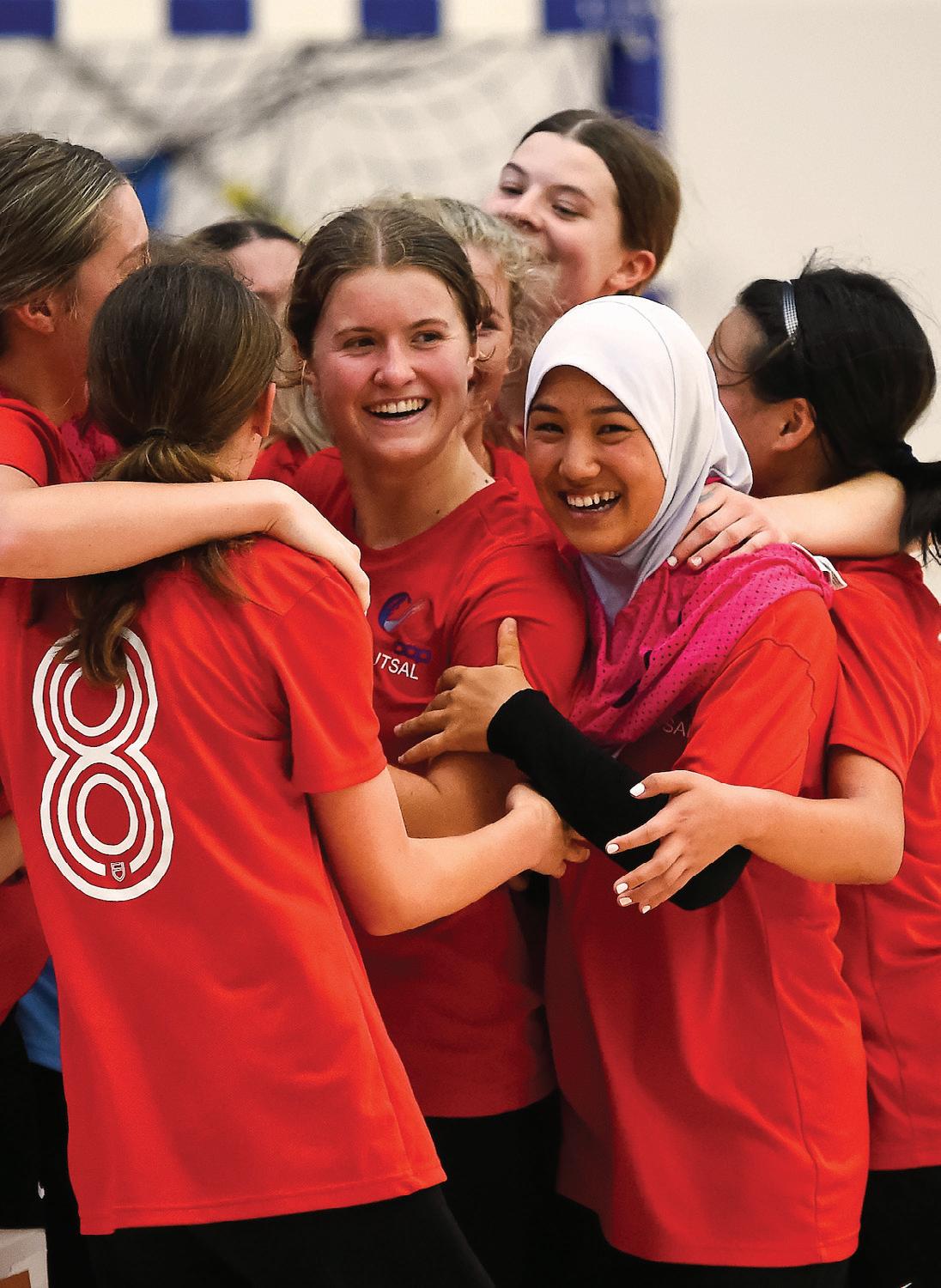
37 Tukutuku Kōrero 13 March 2023
Students answer questions such as why whakapapa and tūrangawaewae are important to culture and collective identity in Aotearoa New Zealand, the impact of immigration on this identity, how connecting with one another involves rights and responsibilities, and how our culture and collective identity continues to evolve.
Ākonga then research how major sporting events provide opportunities to connect with people globally and how these events can help further shape us.
Other subjects explored include: how sports like football and futsal contribute to identity, and similarities and differences between the cultures of World Cup hosts, and how hosting major sporting events in Aotearoa help to shape our culture and collective identity.

The learning experiences went through a final testing and review process in term 1, 2023 and are available to kaiako from the beginning of term 2.
Games support learning
Meanwhile, New Zealand Football, Māori Football Aotearoa, and the Oceania Football Confederation have designed a set of games for ākonga that support the Kōtuitui classroom learning experiences. From term 2, kaiako can join a community coach education session at a football club or federation to learn about how to integrate the football and futsal games with classroom learning.
In addition, around 100 selected schools and kura nationally will receive an in-school delivery programme of these games, facilitated by their local regional football federation. All participating schools and kura will be supported to hold a mini world cup festival to celebrate and share their research at the end of their Kōtuitui learning journey.
Healthy Active Learning regional lead at Sport Canterbury Dean Rouston says, “Our advisors and community connectors have enjoyed working alongside kaiako as Kōtuitui has been
developed. We are looking forward to supporting schools and kura in our region as they participate and then run their own festivals.
“It’s incredibly important that we use the knowledge and experience of kaiako in the development of teaching resources, as this approach helps ensure they are fit for purpose.”
In Our Backyard
Kōtuitui is the fifth ‘learning with sport’ topic to be developed as part of the ‘In Our Backyard’ project, which is led by Sport NZ in partnership with the Ministry of Business, Innovation and Employment (MBIE), and four national sports organisations.
In Our Backyard is developing new opportunities for ākonga to learn with sport as Aotearoa New Zealand hosts a series of major sporting events.
Sport NZ tamariki lead Karen Laurie says, “In Our Backyard is all about putting young people’s wellbeing at the centre of the way in which sports engage with schools and deepening our collective understanding of how quality sport experiences can support and enhance local curricula or marau-ā-kura.
“We have been really encouraged by the progress cricket and rugby made in reshaping how they engage with schools and kura as they hosted their women’s world cups and are excited by what New Zealand Football has planned for schools and kura as the FIFA Women’s World Cup 2023TM gets underway,” says Karen.
38 Education Gazette gazette.education.govt.nz
Understanding different cultures is a key opportunity from global sporting events being hosted in Aotearoa.
Get involved in Kōtuitui and register
Develop collective wellbeing for your learning setting. Our accredited facilitators can work with your group on a wellbeing programme customised for your context. We use the highly-regarded New Zealand Institute of Wellbeing and Resilience (NZIWR) programme, designed specifically for Aotearoa New Zealand.


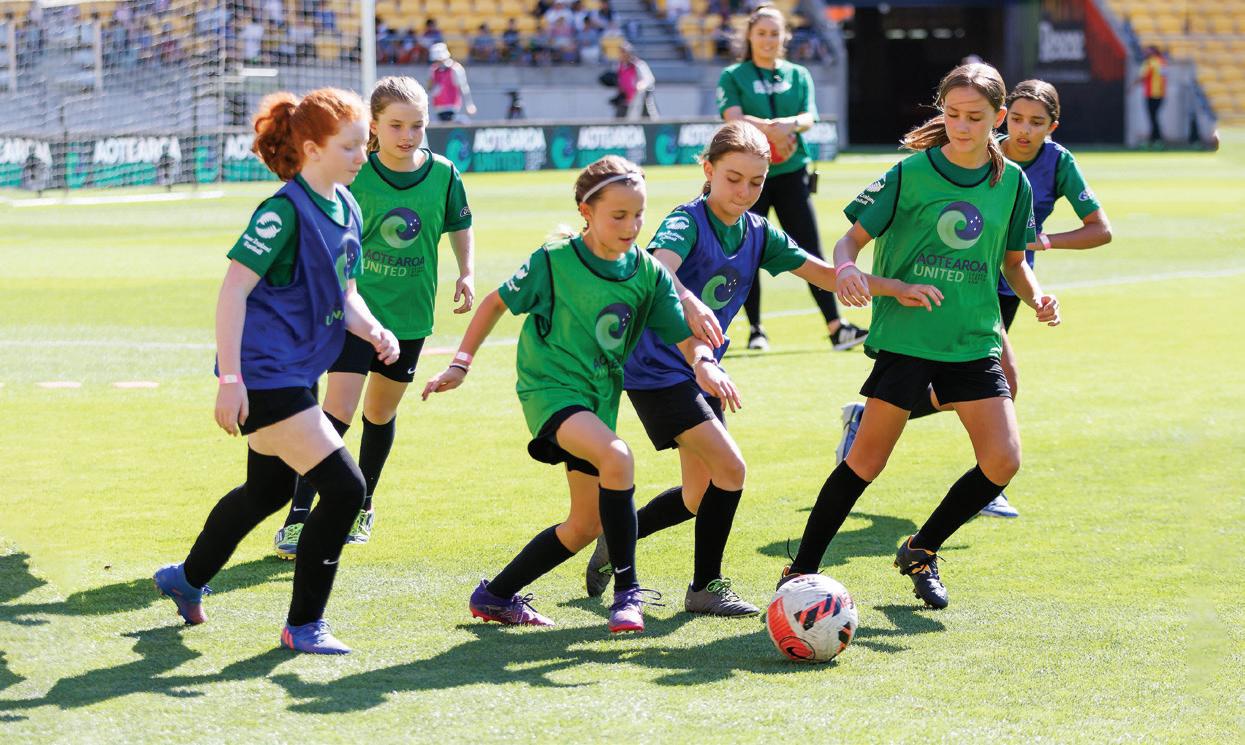
39 Tukutuku Kōrero 13 March 2023
Find out more: Contact Ngaire Shepherd-Wills, Professional Learning Manager ngaire.shepherd-wills@core-ed.ac.nz 021 166 0158 Visit core-ed.org/wp In partnership with
community
The 'In Our Backyard' project is supporting more opportunities for ākonga to learn through sport.
Become a resilient and thriving learning
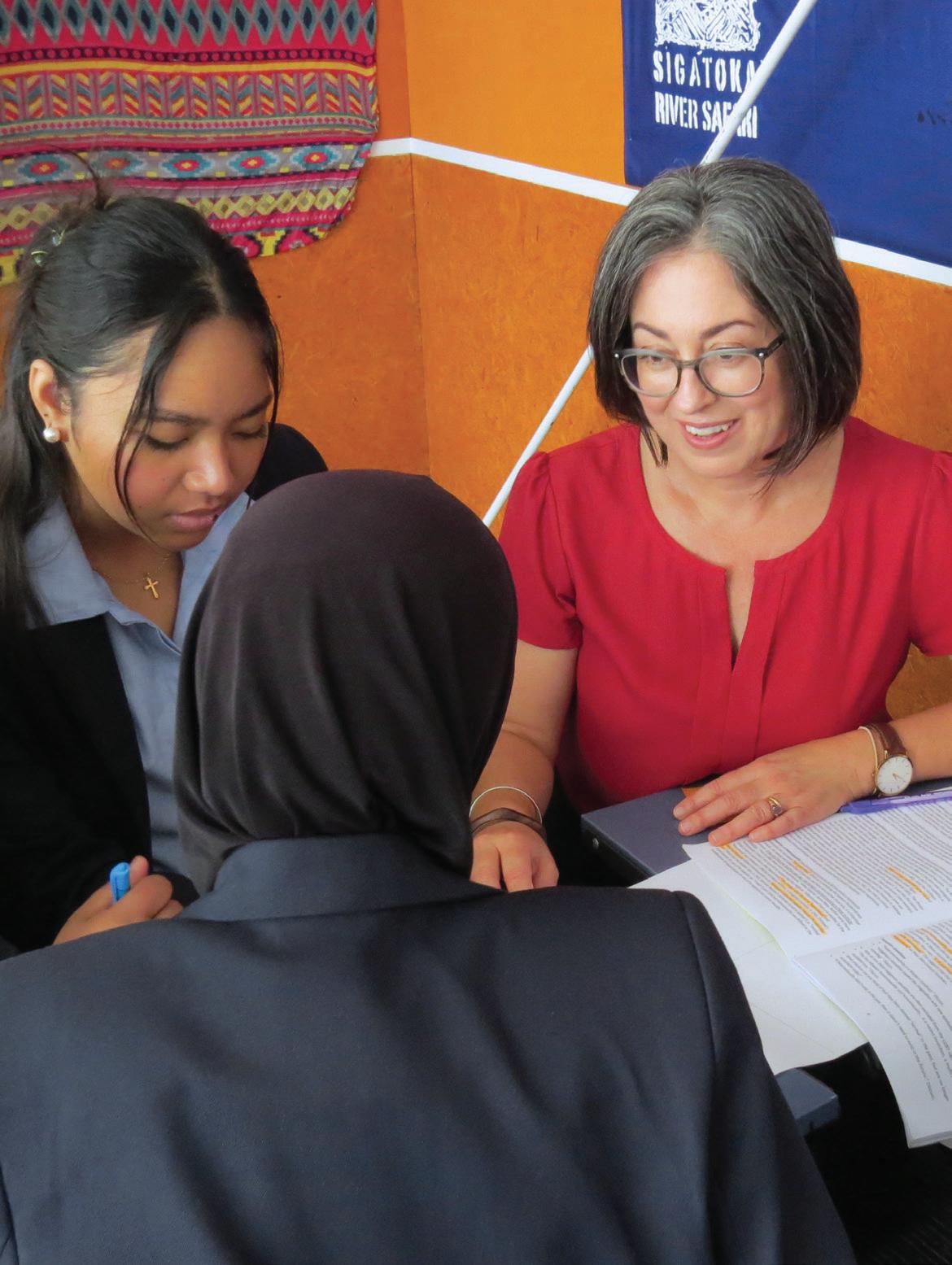
40 Education Gazette gazette.education.govt.nz
Holly enjoys engaging students in civics education.
Photo by Brian Langdon.
Civics and Citizenship Education Teaching and Learning Guide
Available on the School Leavers’ Toolkit website, this is a comprehensive resource that supports primary and secondary school teachers to develop their understanding and practice in relation to effective civics and citizenship education in Aotearoa New Zealand. It is available in both English and te reo Māori, at sltk-resources.tki.org.nz
Creating change through civics education
Civics education is not just about learning the electoral system, it’s also about engaging ākonga in how to interact with government, and how they can create change.
In 2022 the Supreme Court made a declaration of inconsistency with the New Zealand Bill of Rights Act 1990 in relation to the voting age in New Zealand. Currently the age to vote is 18, but there had been activism by young people wanting the age to be lowered to 16. While Parliament is still to decide whether the age will be lowered, the situation does highlight the importance of civics and citizenship education for all ākonga.
In the same year, there was also a review of the All-ofGovernment Child and Youth Wellbeing Strategy. One of the recommendations was to ‘Explore ways of increasing promotion of existing civics and citizenship education resources, and encourage their wider use within the school system and beyond’.
Engagement with children and young people found that many didn’t know how or why to engage with government, but they want the opportunity to learn more about civics and their rights.
Two schools that have been meeting this challenge are One Tree Hill College and Taitā College.
Critical thinking
Holly Bodman is a kaiako at One Tree Hill College, Auckland, and leads their civics and citizenship programme. Her journey into civics education came from travelling the world and seeing the lived experience of developing countries and countries that displayed the impact of colonisation.
“This started a passion to teach critical thinking so that young people can have their minds opened to ways of engaging with society to create the kind of world they would like to live in,” she says.
Holly believes it is critical to provide students with frameworks to unpack their own lived experiences, rather than the teacher being the fountain of all knowledge.

41 Tukutuku Kōrero 13 March 2023
CITIZENSHIP
“My teaching philosophy is very much based on the reciprocity of ako, that teachers both teach and learn at the same time. I teach and I learn from my students who have really rich lived experiences that they can draw on in order to understand the world and to interpret different world views.

“Many students have experienced systemic racism and patriarchal colonial values, so understand the influences that can exist within a society. What civics education can do for students, is help them to question these influences and look at ways to disrupt them.
“It’s about giving students the tools to interpret their
own lived experiences and critiquing the way things are; alongside that is understanding how change can come about and supporting students to take action on issues they care about.”
Examples of projects
One example of the projects that Holly runs is with Ihumātao, where Year 12 students learn about SOUL’s campaign to prevent Fletcher Building’s residential housing project from going ahead. Students learn about the way SOUL engaged with local and central government, the United Nations and the negotiations led by the Kiingitanga. Ākonga visit Ihumātao and learn about SOUL’s actions by talking with Pania Newton, the media face of the campaign.
“Students learn about those different avenues for bringing change as well as the use of direct action and protest. It’s been very exciting for me as a teacher to be able to talk with students about Ihumātao as it is one of the few settlements and negotiation to take place outside of the Waitangi Tribunal.”
A Year 13 project that looks further abroad is about the Indonesian Government’s military occupation of West Papua since 1962. Students examine Aotearoa New Zealand’s relationship with Indonesia and successive New Zealand Governments’ policy of non-interventionism in West Papua.
“Students work in small groups to take action for West Papua, and last year we had one group successfully lodge a Parliamentary petition which calls for the banning of importation and use of kwila wood,” Holly proudly states.
Kwila is a hard wood akin to kauri. Foreign consumer demand for kwila is contributing to the deforestation in West Papua, which in turn negatively impacts indigenous tribes living in the rainforests.
Promoting change
Michael Harcourt, head of social studies at Taitā College, Lower Hutt, also takes an approach of engaging students in the process of promoting change.
“I would say that the intersection of civics with citizenship is my passion. I see civics as the content knowledge of how democratic societies work. Whereas citizenship has students actually participating within and even outside of these systems. When we have them working together you’ve got transformative education, transformative social studies.”
Michael sees the potential for civics knowledge to become another abstract body of knowledge that students struggle to understand or retain. The way to overcome this is to embed the knowledge within the context of engagement with contemporary contested social issues.
One way to approach this, he says, is to guide topics with questions that are quite open-ended, but not so openended that they are impossible to answer.
Michael adds that the questions are ones that people in our democracy would answer in different ways, so it requires students to come to grips with multiple perspectives to form their own.
42 Education Gazette gazette.education.govt.nz
“It’s about giving students the tools to interpret their own lived experiences and critiquing the way things are; alongside that is understanding how change can come about and supporting students to take action on issues they care about.”
Holly Bodman
Contemporary issues
Taitā College students have been able to engage with a contemporary issue for the area, which is whether the school should have a macron placed on its name. The New Zealand Geographic Board determined that the area should have a macron on the second ‘a’ (Taitā), which has been adopted for parts of the area.
“So, we’re getting students to think about the question, ‘Why are macrons important?’
“Then we are looking at other schools and other contexts that have had discussions about naming and getting the students to select someone in a position of power to write a letter to, saying what they think should happen,” Michael says.
These types of activities, whether it is local issues or contemporary international issues, allow students to think about power structures, and who can be contacted to obtain change.
Michael’s students did also engage in the debate about voting age. He was delighted that within the class, there were different and opposing views put forward, creating an atmosphere of ideological diversity where each ‘side’ had to listen and evaluate the opposing arguments.
While some students may have found this difficult, Michael stresses that this is at the heart of good social
studies education, the ability to find yourself in the world, take a position and then potentially act on it.
“Some may say the purpose of social studies education is to learn about society, but I do not think that goes far enough. I think that as teachers, we need to really get our heads around how we might get students more engaged, but not just in the political process, although that is a good start. We need to think about citizenship education as going beyond engagement with the electoral process.”
Understand, know, do
Civics and citizenship education is linked to a number of progress outcomes as part of the refreshed Te ao tangata | Social sciences curriculum.
Read more about the refreshed curriculum at curriculumrefresh. education.govt.nz
REGISTER NOW FOR KIDS VOTING TE PŌTI A NGĀ TAMARIKI
Foster the next generation of civics-savvy New Zealanders and give your students the opportunity to have their say with Kids Voting –Te Pōti a Ngā Tamariki.
Students vote for real parties and candidates and compare their results with the 2023 General Election.
We’ll support you with everything you need to run your own election, including free teaching resources to aid your students’ learning.
Find out more and register your school at kidsvoting.nz
43 Tukutuku Kōrero 13 March 2023
Day in the life of a school bus controller
The Ministry of Education school transport service helps over 100,000 ākonga get to and from school. Bus controllers play an important part in enabling this service.
The bus services are essential for ākonga in rural areas.

44 Education Gazette gazette.education.govt.nz
SCHOOL TRANSPORT
Denise Jones is the principal of Tatuanui School, a rural school catering for 140 ākonga up to Year 6. She is also the school’s bus controller, a role that is not fully appreciated until you find out just what it involves.
“It’s a sort of role that is typical of teaching and education in general, no two days are the same and you won’t have the same problem all the time,” says Denise.
School transport assistance is provided by the Ministry of Education to help ākonga overcome barriers to education, such as distance or accessibility.
Every day, over 100,000 ākonga use a Ministrycontracted daily school bus to get to and from school.
Shelley Grant from the Ministry’s Te Puna Hanganga, Matihiko | Infrastructure and Digital group, says bus controllers play an important role in the delivery of school bus services.
“A bus controller is a permanent employee of the school (such as a teacher or principal), who is a point of contact for Ministry-contracted daily school buses. They have a very important role as they are our people on the ground.”
Shelley describes the role as being a complex position, in charge of both safety and administration. Bus controllers have to develop procedures to make sure that the location where the buses arrive at school is safe and that ākonga are getting off and on the bus safely. They are also responsible for answering any questions caregivers have about the school bus service, as well as promoting safe behaviour by ākonga while they are using the school bus.
Learning the system
Denise describes her first experience as a bus controller as a baptism of fire. She had not previously been involved in rural life so was unaware of the system required to get ākonga to school in rural areas. She had to quickly learn what the eligibility criteria for school transport assistance was and how it applies to different ākonga.
“Parents can get confused about what the eligibility criteria are, and they will say things like, ‘But the bus goes past my house to your school. Why can’t my child get on it?’ or, ‘Why can my intermediate child get on the bus at the end of the drive but my Year 4 student can’t?’
“So, you have to have the knowledge that there are
formulas for working out distances between home and school, and school to school, as to whether tamariki are eligible.”
Shelley says there are three criteria ākonga must meet to be eligible for a Ministry school bus. First, ākonga must be going to the closest school where they can enrol; second, they must live more than a certain distance from the school, and third, there must be no suitable public transport available.
A hands-on approach
Denise likes to have more than just theoretical knowledge of the service – she will also travel the school bus routes to understand where the stops are and what areas are covered.
“Every year I will always get on a bus and travel the bus routes with the bus drivers. Other bus routes I will drive. It gives me a good picture of where my children are, and where they have to go to so they can get on the bus.”
For some ākonga the stop may be right outside their home, for others they may have to travel to a stop. The reasons for having to travel may be due to safety, such as a lack of turning space for the school bus at their home, or there may not be enough other ākonga living near them to warrant a bus stop up their road.
These ākonga may be entitled to a conveyance allowance to help caregivers get them to the nearest pick-up/drop-off stop. Speaking on behalf of parents with the Ministry in this situation is another role of the bus controller.
Liaison and communication are a major part of the role. The bus controller is the liaison between the Ministry of Education, caregivers, the bus company, the community, and other schools.
Shelley says the bus controllers have to be available at all times in case something happens, for example, the road slips that occurred during extreme weather this year.
“They’ll get contacted by the transport provider who’ll say, ‘This road is no longer passable, we need to change the bus route so these ākonga can’t get picked up at their normal bus stop’. The bus controller will then have to contact the caregivers to let them know that their tamariki won’t be picked up as normal by the school bus that day.”
45 Tukutuku Kōrero 13 March 2023
“It’s a sort of role that is typical of teaching and education in general, no two days are the same and you won’t have the same problem all the time.”
Denise Jones
Whanaungatanga is key
Communication is important in the role, as it helps to reduce other problems such as bus overloading.
Denise comments that a few years ago they found out one of the buses was getting overloaded. When it was investigated, they found there were several ineligible ākonga getting on the bus and travelling to school. Denise then had to let the caregivers of the ineligible ākonga know that they weren’t able to put their tamariki on the bus and explain why this was the case.
Denise says that having good relationships is the key to making the service a success.
“We’ve got a positive relationship with all our schools using our bus service. As there are usually siblings on the bus from primary, intermediate and college, the older students show courtesy, care, and respect.
“If the college students see our little 5-year-olds getting on the bus and there’s no seats, they will ensure our primary school children are seated.”
Liaising with the other schools who share their bus service is also important when it comes to addressing any behavioural problems on the school bus.
“Any issues that may arise from time to time we quickly follow up with the other schools and we work together to get things sorted.”
Day to day responsibilities
As well as understanding the eligibility criteria and maintaining lines of communication with caregivers, there are also everyday activities such as ensuring ākonga get onto the correct bus when school is finished.
At Tatuanui School, a teacher has the responsibility for gathering ākonga and putting them into the right queue for their bus. The system works well, and the school continually reviews systems to ensure best practice for safety. However, there was one instance a few years ago that led to the school instantly tightening up the system.

A 5-year-old had been placed in his queue, but he noticed that the other bus, which went the opposite way to where he lived, was a nice new shiny bus.
He decided that he would like to travel on the new bus so changed bus queues. He was not discovered until the bus driver finished his run and discovered he had a child left over. The bus company contacted the school, saying they were looking after a “little person”.
The school had just been alerted by an anxious parent that their child had not got off at his bus stop. From here, the situation was quickly resolved, and a relieved parent went to the bus depot to collect a content 5-year-old. The system at the school now includes counting ākonga as they get on the bus.
Denise is delighted that there is now online training for bus controllers.
Shelley says, “The whole point of the online training is to make it easy for our bus controllers to access the training in their own time.
“We really appreciate the job they do as they are such an integral part of getting the ākonga to and from school safely. Without them, this would be so much harder. We couldn’t do it without them.”
Online training for bus controllers
Bus controllers play a vital role in helping ākonga get to and from school safely. The Ministry now offers an online training module for all bus controllers (new and existing) that helps explain the role and responsibilities.
This training builds knowledge for a bus controller, including information on their responsibilities, the eligibility criteria, and suggestions for bus safety training. There are also scenarios and quizzes that test knowledge at each stage of the training.
To access the course:
» Go to training.education.govt.nz
» Login via your ESL Logon
» Search ‘Catalogue’ for ‘Bus Controller’
46 Education Gazette gazette.education.govt.nz
Denise takes a hands on approach to being a bus controller.
Gold Star helps you prioritise your mental health
Get on board with Gold Star and join like-minded colleagues who are learning more about mental health, to help in your everyday life.

The Ministry of Education and EAP Services are behind Gold Star, a wellbeing programme designed specifically with early childhood, school and kura workers in mind.
Visit Gold Star online to find our webinars and eLearning modules that are made especially for you, to help better understand mental health, and how we can improve our wellbeing.
Remember, you always have access to counselling through EAP Services. Talking with one of our fully registered counsellors can make a world of difference. You can make an appointment here: bit.ly/3IQhYlu
Find us at www.goldstar.nz

Sign up for Gold Star for free and discover the benefits:
• Help you feel less stressed at work
• Build resilience in times of change
• Guide your personal development or career direction
Sign up for free
Scan the QR Code to sign up and start your first module.

www.goldstar.nz
• Give you tools to handle conflict or tension in the workplace
• Offer resources to support you with lifestyle or health issues
© 2022 EAP Services Ltd – Partnering for Performance – The Ministry of Education
More support to improve school attendance
The Government has launched a plan to get young people back into the classroom with more attendance officers in schools and more support for the Attendance Service.
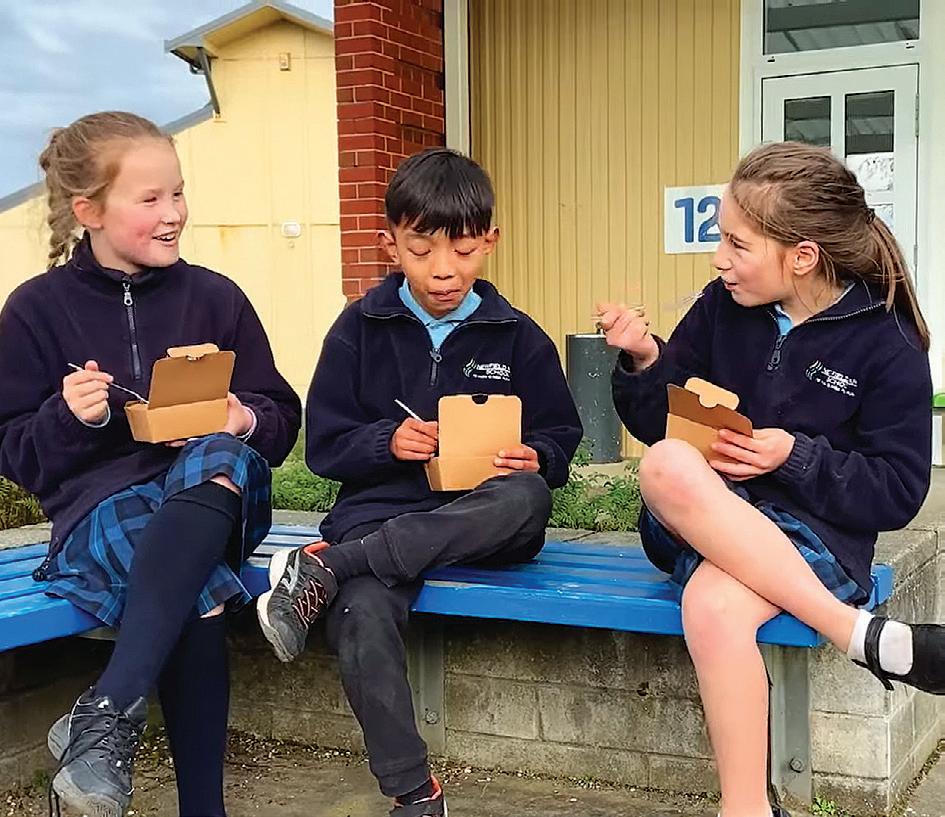
In February, the Government launched the School Attendance Turnaround Package, which complements the initiatives already underway to assist kura and schools in supporting ākonga to re-engage with their learning.
These additional resources also aim to help achieve the targets set out through the Attendance and Engagement Strategy, launched in 2022.
The package includes funding for:
» eighty-two new attendance officers who will work with schools in supporting students who are irregularly or moderately absent
» increasing the capacity and addressing cost pressures of the Attendance Service
» developing an improved and standardised system for attendance data collection and analysis.
48 Education Gazette gazette.education.govt.nz
ATTENDANCE & ENGAGEMENT
All in for learning I Kia kotahi te ū ki te ako emphasises how children need every opportunity to learn, participate, and flourish by regularly attending school or kura.
Minister of Education Jan Tinetti reiterates how important it is for young people to be at school and learning.
The new attendance officers will work with students who have low or declining attendance rates, to ensure they are going to school every day unless they are sick. They will work alongside parents and schools to turn around attendance rates.
The Attendance Service already works with students who are chronically absent, or not enrolled at all, and this will help it to support 3,000 more young people.
“The decline in school attendance began in 2015, but the pandemic has exacerbated the issue. We need to be doing more to help schools and kura support students who are not attending or engaged in education,” says Minister Tinetti.
This package builds on investments such as the Regional Response Fund and other funding for programmes that help young people engage in learning, as well as the ongoing work through the Attendance Strategy and attendance campaigns launched last year.
“We have seen results already through the Regional Response Fund, which has showed that early intervention with students whose school attendance is falling can make a huge difference.
“We know that there are many reasons why a child might not show up to school. These measures will, over time, ensure that young people right across the country are attending, want to be at school and are on the right path to success in their education,” says Minister Tinetti.
All in for learning | Kia kotahi te ū ki te ako – Attendance and Engagement Strategy
The Government has developed a strategy for tackling the decade-long decline in regular attendance and engagement in schools. The strategy sets expectations of ākonga and whānau, schools, communities and government agencies in addressing this complex problem. It builds on work that government has already been undertaking alongside schools and communities to address attendance and engagement issues.
Education Gazette Series: Attendance and engagement
This series highlights the mahi underway in schools and kura across Aotearoa New Zealand that is having a positive effect on attendance and engagement in a local context.
Community partnership approach to ākonga re-engagement
Under the Napier-based Te Tupu pilot programme, a range of services and agencies collaborated to provide a tailored support system across 22 schools for Year 3–8 children at risk of disengagement from learning or of exclusion.
The role of a re-engagement officer
Mariah Scott works as a re-engagement officer across the Tawa Kāhui Ako in Wellington. The role is designed to help students who are not engaging with school and involves meeting with them and their families to find out what’s going on in their environment, both inside the classroom and at home.
Northland schools join forces to help students get to school
A strong desire to get their tamariki back to school brought primary and secondary school principals together in Te Tai Tokerau Northland. Last year, they launched a campaign – Let’s Get to School Tai Tokerau – in the hopes of rallying communities to help students get to school.
To read more in the series, visit gazette.education.govt.nz.
49 Tukutuku Kōrero 13 March 2023
Visit Te Mahau to learn more about All in for learning | Kia kotahi te ū ki te ako. Read more about the Attendance and Engagement Strategy.

13 March 2023 51 Tukutuku Kōrero ISSUE EDITORIAL ADVERTISING BOOKING DEADLINE VACANCY BOOKING AND ALL ARTWORK DEADLINE BY 4PM PUBLICATION DATE 102.4 17 March 22 March 3 April 102.5 6 April 12 April 24 April 102.6 28 April 3 May 15 May 102.7 19 May 24 May 6 June 102.8 9 June 14 June 26 June 102.9 30 June 5 July 17 July 102.10 21 July 26 July 7 August 102.11 11 August 16 August 28 August 102.12 1 September 6 September 18 September 102.13 22 September 27 September 9 October 102.14 13 October 18 October 30 October 102.15 3 November 8 November 20 November 102.16 24 November 29 November 11 December Education Gazette Publication
dates 2023
Scan
Ohakune, kia
tō
kura ki te keokeonga o tō tātau maunga e tū mai nei.
Te Kura Kaupapa Māori o Ngāti Rangi, based in Ohakune at the foothills of Koro Ruapehu, is seeking qualified applicants for the position of Tumuaki, to lead, grow and develop our school to reach heights akin to the pinnacles of our ancestral mountain.

Applications will remain open until the position is filled. If you have any questions or wish to have a confidential discussion, please make contact with the Presiding Member, Elijah Pue via email on chair@ngatirangi.school.nz or call 027 740 6253.
The application pack can be found on our website www.ngatirangi.school.nz.


Do you have a vacancy that you would like to advertise to the education sector? Place an advertisement in the vacancies section and reach both the passive and active jobseekers by contacting Jill Parker: jill.parker@nzme.co.nz 027 212 9277 Te Kura Kaupapa Māori o Ngāti Rangi 40 Burns Street Ohakune Email: chair@ngatirangi.school.nz
(KAIWHAKAAKO HOKI) Wā kikī, ka tīmata a te wāhanga tuatahi o te tau 2023 Ko te reo pōhiri tēnei o Koro Ruapehu ki te Tumuaki hou o Te Kura Kaupapa Māori o
Rangi
TUMUAKI
Ngāti
ki
ārahina
tātau
To view the PLD, general notice listings and vacancies at gazette.education. govt.nz
the QR codes with the camera on your device. VACANCIES NOTICES PLD NOTICEBOARD VACANCIES
Applications and referees’ reports are due by 4pm, Friday 31 March, 2023.
For an application pack or confidential inquiries, contact Linley or Stuart Myers, smyersmbl@gmail.com.
Tumuaki/Principal U5
Birkdale Intermediate School sits in the vibrant suburb of Birkdale, close to native bush and Auckland’s Upper Harbour. This is an exciting opportunity for a visionary Tumuaki with outstanding interpersonal skills and the expertise to advance the direction of our school. Tamariki and whānau represent the bicultural and multicultural nature of Aotearoa/New Zealand.
The school is supported by its whānau and community and is positioned to provide exceptional 21st Century learning. The school vision is for a quality education in a caring environment. Mā te manaakitanga te kounga o te mātauranga e whanake.
The Board seeks a motivational, collaborative and inspirational leader who can build a strong and engaged team and positively embrace modern pedagogical practices. This is a wonderful opportunity to lead an intermediate school, the delightful rangatahi that learn at this level and its community into the future.
At Christ the King we regard education as a lifetime journey. Within the caring and nurturing atmosphere which characterises our school, values are taught and lived, high standards of personal integrity are encouraged, and a strong cultural, social awareness and concern for others is expected.
We are seeking an enthusiastic and motivated Tumuaki with excellent proven leadership, pedagogical knowledge and the ability to implement the refreshed curriculum, including the Catholic curriculum.

This is a tagged position, where a willingness and ability to take part in religious instruction appropriate to the Catholic special character, is a condition of employment.
We seek a Catholic leader who has:
• Proven strong, passionate, Catholic faith leadership and is motivated by Catholic educational values and the Principles of Catholic Social Teaching.
Christ the King Catholic Primary School
Principal/Tumuaki
Full time, Permanent
Christ The King School is a fully integrated Catholic Primary School in the Burnside area catering for boys and girls from New Entrants to Year 8.
Proven leadership skills with the ability to think strategically and inspire students, staff, and community.

• Proven strong curriculum leadership and experience in relational pedagogy and culturally responsive practices.
• A desire to foster and develop strong positive partnerships with all stakeholders. Experience in achieving excellent educational outcomes for tamariki through a faith filled, inclusive, positive and purposeful learning environment.
• A commitment to promoting and being actively involved in the wider life of the school through Catholic special character, sporting, cultural and community activities.
If you would like to “Step up for Success “ to lead our amazing kura, we would love to hear from you. Requests for the application pack, enquires and application submissions should be directed to Rebecca Methven, chairperson@christtheking.school.nz
This vacancy closes at 5pm on Thursday 6th April 2023

53 Tukutuku Kōrero 13 March 2023 VACANCIES
Get your class excited about STEM

Secure your spot in the Rocket Challenge before lift-off!
The Wonder Project Rocket Challenge is blasting off at the beginning of Term 2. Make sure you secure your spot on this epic free, industry supported programme to engage and inspire your ākonga with STEM this year.
After last year’s challenge:
• 93% of teachers noticed students’ perceptions of STEM improved
• 80% of students felt more confident in STEM subjects
• 96% of teachers felt more confident teaching STEM
• 79% of students and 99% of teachers would take part again
Take the pressure off planning for the school year. Sign up for Term 2 now.
wonderproject.nz
POWERED BY
@WonderProjectNZ
























 CYCLONE
CYCLONE






 Tamatea Intermediate School had many fallen trees to clean up, including a large 40 year old tree that was likely planted when the school first opened in the 70s.
Tamatea Intermediate School had many fallen trees to clean up, including a large 40 year old tree that was likely planted when the school first opened in the 70s.


















































 The CGM on Grace’s arm, along with an insulin pump, gives her greater freedom to be active and independent.
The CGM on Grace’s arm, along with an insulin pump, gives her greater freedom to be active and independent.
































